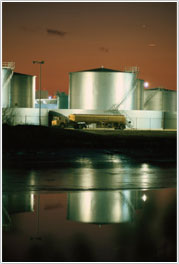
What to do with the "waste" produced in all areas of society from day-today activities has become one of the most urgent environmental issues of the 21st century—Recycling, in the classical sense, has proven to be uneconomical , with very few exceptions because of the cost of transportation, rising energy costs, and disposal of "waste". This places a very heavy burden on all municipalities, industries, and other institutions because it is increasingly difficult to find safe, effective, and "clean" methods to dispose of "waste".
Landfills or incineration of this waste are "stop-gap" methods that have been employed far too long. Stockpiled rubber tires are one of the largest of these "waste" problems.
This is especially a concern in municipal, industrial, and medical areas, each with its own problems for safe disposal. Recycling, in the classical sense, has proven to be uneconomical, with very few exceptions and the waste must be "clean". Once the waste reaches the waste bin, it is no longer suitable. This mixed mass is seldom destined to be recycled and ends up in a landfill or an incinerator.
 The cost of transportation is rapidly becoming so excessive that most recycling is no longer economical. Transportation and disposal costs are placing a very heavy burden on all municipalities, industries, and medical institutions. This, coupled with the rising costs of energy, demands that a new approach to this problem be taken.
The cost of transportation is rapidly becoming so excessive that most recycling is no longer economical. Transportation and disposal costs are placing a very heavy burden on all municipalities, industries, and medical institutions. This, coupled with the rising costs of energy, demands that a new approach to this problem be taken.
Municipal waste has the greatest volume of man-made natural resources consisting of every material used in our daily life. Not only does this material consist of what we consider to be unusable discards, but we also inoculate this 'soup' with our pathogenic bacteria. Incineration is not acceptable. The most advanced incinerator produces massive amounts of toxic gases. Many, in contact with water, produce acids. These acids affect both animal and vegetable life adversely. Land filling is objectionable from the standpoint of being a waste of a valuable resource, but also from the standpoint of the pollution it causes to the ground, water, and air.
Industrial waste, while not as great a mix as municipal waste, is of almost equal volume. This material is generally a "clean" waste, which consists of fairly 'pure' streams. Waste oil, tires, and plastics are generally collectible in a singular state, and as such, can be used in the production of various compounds and/or energy. Medical waste poses a very serious problem. This material consists of paper, paper coated with plastics, plastics of many types, and textiles, all of which can be heavily contaminated with body fluids and fecal matter.

 Disposal of used tires is an ever growing problem worldwide. On a yearly average there is an estimated 290 million scrap tires generated in US and an estimated 2 billion stockpile today. Locally its estimated at 19 million scrap tires per year in Texas. Tires in landfills/dumps and failed uses like reefs are environmental tragedies.
Disposal of used tires is an ever growing problem worldwide. On a yearly average there is an estimated 290 million scrap tires generated in US and an estimated 2 billion stockpile today. Locally its estimated at 19 million scrap tires per year in Texas. Tires in landfills/dumps and failed uses like reefs are environmental tragedies.

 What to do with the "waste" produced in all areas of society from day-today activities has become one of the most urgent environmental issues of the 21st century—Recycling, in the classical sense, has proven to be uneconomical , with very few exceptions because of the cost of transportation, rising energy costs, and disposal of "waste". This places a very heavy burden on all municipalities, industries, and other institutions because it is increasingly difficult to find safe, effective, and "clean" methods to dispose of "waste".
What to do with the "waste" produced in all areas of society from day-today activities has become one of the most urgent environmental issues of the 21st century—Recycling, in the classical sense, has proven to be uneconomical , with very few exceptions because of the cost of transportation, rising energy costs, and disposal of "waste". This places a very heavy burden on all municipalities, industries, and other institutions because it is increasingly difficult to find safe, effective, and "clean" methods to dispose of "waste". The cost of transportation is rapidly becoming so excessive that most recycling is no longer economical. Transportation and disposal costs are placing a very heavy burden on all municipalities, industries, and medical institutions. This, coupled with the rising costs of energy, demands that a new approach to this problem be taken.
The cost of transportation is rapidly becoming so excessive that most recycling is no longer economical. Transportation and disposal costs are placing a very heavy burden on all municipalities, industries, and medical institutions. This, coupled with the rising costs of energy, demands that a new approach to this problem be taken.